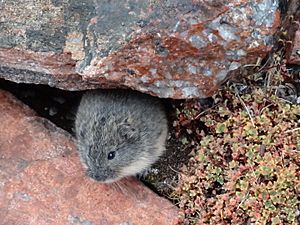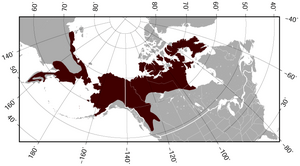Canadian lemming facts for kids
Quick facts for kids Canadian lemming |
|
|---|---|
 |
|
| Canadian lemming | |
| Conservation status | |
| Scientific classification | |
| Genus: |
Lemmus
|
| Species: |
trimucronatus
|
 |
|
| North American brown lemming range (includes range of L. nigripes) | |
The Canadian lemming or Nearctic brown lemming (Lemmus trimucronatus) is a small North American lemming. These furry little animals live in the cold, northern parts of North America. They are known for their quick movements and their important role in the Arctic food web.
Contents
About the Canadian Lemming
Scientists have learned a lot about different types of lemmings. For a long time, the Canadian lemming was thought to be the same as the Siberian brown lemming. Later, they were seen as different species.
Then, the Canadian lemming was grouped with the Beringian lemming. They were called the "North American brown lemming." But new studies show that these are also separate species. Even so, they are still very closely related.
What They Look Like
Canadian lemmings are mostly brown. Their backs and rumps are a reddish-brown color. Their heads and shoulders are grey.
In winter, their fur grows longer and becomes even greyer. Female lemmings are about 12.5 centimeters (5.7 inches) long. They weigh around 58 grams (2.4 ounces). Males are a bit bigger, about 13 centimeters (5.9 inches) long. They weigh about 68 grams (2.7 ounces).
Like other lemmings, they have small ears and short legs. Their tails are very short. Their feet have bristles on the soles and toes. This helps them dig burrows in the ground.
Where They Live and What They Eat
Canadian lemmings live in the tundra areas. You can find them in northern Canada, including Nunavut, Northwest Territories, and Yukon. They also live in southern Alaska, below the Alaska Range. Some are found on the west coast of British Columbia.
They mainly eat grass shoots. They also enjoy other tundra plants. This includes sedges, moss, bark, berries, lichens, and roots.
Many animals hunt lemmings. These include most carnivores (meat-eaters) and certain birds. Sometimes, even caribou might eat them. When there are not many lemmings, some predators, like the Arctic fox, might not be able to have babies. This shows how important lemmings are to the Arctic ecosystem.
Living in Colonies
Canadian lemmings live underground in groups called colonies. They can have up to three groups of babies each year. This includes during the winter, under the snow.
A female lemming is pregnant for about 23 days. She gives birth to four to nine young at a time. Canadian lemmings do not travel far from their homes. If there are too many lemmings in one area, they might fight each other. This often happens during mating season.
On Bylot Island, there are many wet areas. These places have lots of mosses, grasses, and sedges. This is a perfect home for Canadian lemmings. They especially like to live in wet, grassy areas. These areas provide the plants they need for food.
During winter, brown lemmings live in warm burrows underground. They build their nests using sedges and grasses. These deep burrows keep them warm. This allows them to have babies even in the cold winter. Studies show that lemmings prefer to burrow under deep snow. Deeper snow traps more heat. It also protects them from birds that hunt from the sky. Mammal predators can still find them, but deep nests make it harder.
In summer, the snow melts. Lemmings no longer have the snow cover. Their territories spread out more across Bylot Island.
See also

- In Spanish: Lemming canadiense para niños


